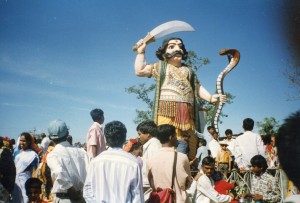Who’s who in the Rg Veda? Who were the main deities that ancient Indians worshipped in their oldest text?
We’ll find that some of ancient India’s gods were very different from the Greek Olympians. These differences helped set India on a unique intellectual course which has been one of the world’s most creative.
1. The most frequently honored deity in the Rg Veda was Indra, a sky god of storms and thunder, and a hero associated with battle. He was a lusty fellow who loved feasting, drinking and adventures, like Greece’s Zeus. He was often accompanied by the Maruts. They were lesser storm gods that rode chariots and sang war songs as they helped their leader in the fray. Indra and his Greek cousin were what male warriors wanted to be. They were like ancient rock stars.
The composers of the Vedas and the Greeks shared a common Indo-European heritage. Their ancestors migrated (probably from the southwestern steppes of Central Asia), and entered Greece around 2000 BCE, and India around 1500 BCE. So both cultures were bound to share some traditions. But other Indian gods were uniquely Indian.
2. Agni is the second most frequently mentioned god in the Rg Veda. He embodied fire, which consumed sacrifices and transported them to the sky, where the other gods resided. He wasn’t imagined as a human or animal figure because he ranged all over the universe. He dwelled in the sky, and also in the home’s hearth, and was thus an intermediary between people and the other gods. He existed in plants, and when they were burned, he would fly to the skies. So Agni was everywhere, rather than concentrated in a single personage. He was thus associated with mystical energies.
3. Aditi was The Boundless. She was the mother of the other gods.
4. Savitr was a deity associated with the sun, and he was called The Stimulator. He was a catalyst for cosmic energies.
Savitr and Aditi could easily be seen as impersonal energies that flowed without bounds, rather than identifiable people with consistent personalities that could be put in engaging narratives like Homer’s.
5. One of the most important Vedic sacrifices was the Soma. This was a hallucinogenic plant whose juice was extracted by pounding or pressing with stones. It was then mixed with water and milk. Priests who drank it sang about being greater than heaven and earth. All of Book Nine of the Rg Veda is devoted to its preparation. More than 100 theories about what it was have been proposed, but it sounds like it could have held its own at a Grateful Dead concert. Praise the Lord! Far out, man!
Indian religions have often degenerated to crude forms. In one temple in Kanchipuram, the pot smoke was thick enough to space out an elephant.
But this mixture of ideas blended with the ideas we saw in The Rg Veda, Roots of Indian Culture; Part Two to foster ways of seeing reality that focused on the universe’s vastness, rather than distinct entities and ratios that Westerners have usually favored. We’ll see some of the thoughts that blossomed from this tradition in the next post.



Comments on this entry are closed.